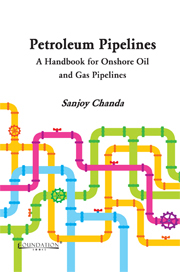Book contents
- Frontmatter
- Contents
- List of Tables and Figures
- Preface
- 1 Introduction: Some Basic Facts about Pipelines
- 2 Pipeline Design and Engineering
- 3 Pipeline Construction
- 4 Pre-commissioning and Commissioning of Pipelines
- 5 Operation and Maintenance of Cross-country Pipelines
- 6 Pipeline Corrosion and its Mitigation
- Bibliography
- Index
- Frontmatter
- Contents
- List of Tables and Figures
- Preface
- 1 Introduction: Some Basic Facts about Pipelines
- 2 Pipeline Design and Engineering
- 3 Pipeline Construction
- 4 Pre-commissioning and Commissioning of Pipelines
- 5 Operation and Maintenance of Cross-country Pipelines
- 6 Pipeline Corrosion and its Mitigation
- Bibliography
- Index
Summary
Petroleum has to be transported from fields where it is produced to places where it is processed and finally to the market. A unique feature of petroleum transportation is that crude oil coming from wells in oilfields is processed in refineries and is brought to the ultimate consumer without being seen by human eyes. This huge flow of petroleum commodities, moving in daily commerce and the technology that has been developed to facilitate the movement, make transportation an important branch of petroleum industry. The modes of transportation available for crude oil and refinery products within the country include river barges, railway wagons, road bowsers and, last but certainly not the least, pipelines. In fact, out of the various modes of transport employed, pipeline is by far the most preferred. Gas, however, can be transported only through pipelines.
This book covers petroleum pipelines – both oil and gas. Though pipelines are used for transportation of various fluids such as water, petroleum, sewage, even solids such as mineral ores in slurry form, long distance cross-country pipelines are by and large meant for transporting petroleum. They carry liquid petroleum such as crude oil, gasoline, naphtha, diesel, kerosene, aviation fuel, etc., natural gas as well as products such as liquid petroleum gas (LPG) and even ethylene and propylene.
- Type
- Chapter
- Information
- Petroleum PipelinesA Handbook for Onshore Oil and Gas Pipelines, pp. ix - xiiPublisher: Foundation BooksPrint publication year: 2013



